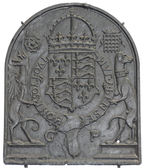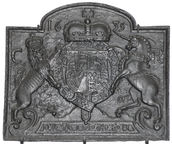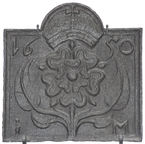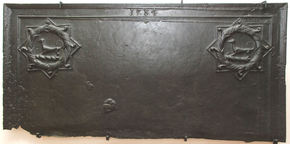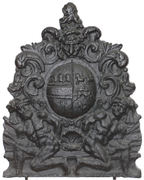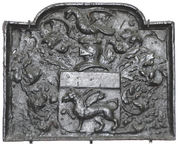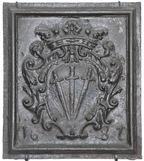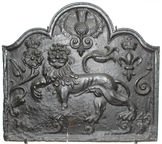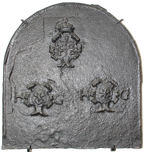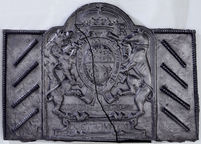-
747
Description: Arch-shaped; fillet edge; Tudor shield, crown, garter (motto clockwise but reversed) and supporters. Crowned rose on dexter, and crowned portcullis (grid of 16) on sinister side of crown; the supporters, a dragon and a greyhound, stand on separate plinths; the initials, G P are placed in either side of the garter buckle.
Notes: There are several firebacks with the Tudor royal arms that were probably originally produced in the Spanish Netherlands, perhaps illustrating the association between England and Spain through the marriage of Henry VIII and Katherine of Aragon. The firebacks differ in several small details, such as the form and rotation of the Garter motto, the style of the crown, the positioning of the supporters in relation to the Garter, and the form and size of the crowned rose and portcullis. Part of the bequest to the Victoria and Albert Museum by Lieut. Colonel G. B. Croft-Lyons in 1926.
Inscription: HONY SOYT QVI MAL Y PENSE / G P
Arms: Tudor royal
- Decoration tags:
- rounded arched (shape)
- fillet (edging)
- whole carved pattern
- heraldic
- armorial
- royal
- text
Manufactured: in the mid-16th century possibly in the Wallonia area of Luxemburg.
Current location: Victoria & Albert Museum, Cromwell Road, Kensington & Chelsea, Greater London, England.
Museum number: M.499-1926 (part of the Victoria & Albert Museum museum group)
- Attached to series:
- Tudor royal armorial firebacks
- Continental Tudor royal armorial firebacks
-
749
Description: Flattened arched rectangular shape; cavetto moulded edge all round; Stuart royal arms with lion and unicorn supporters, crown, garter and motto; CR initials placed separately outside supporters; date split either side of crown.
Notes: A commonly copied variant has the intials, IT, at the top; one vertical plank-line on right side. Inferior copies of this fireback were advertised in Kings Worthy Foundry's (Winchester) catalogue in the mid-20th century.
Copies of this fireback are known.
Inscription: 1635 / C R / HONI SOIT QVI MAL Y PENSE / DIEV ET MON DROIT
Arms: English Stuart royal - Charles I
- Decoration tags:
- rectangular with round arch (shape)
- cavetto (edging)
- whole carved pattern
- planklines
- armorial
- royal
- text
Manufactured: in 1635 possibly in the Weald area of England.
Current location: Victoria & Albert Museum, Cromwell Road, Kensington & Chelsea, Greater London, England.
Museum number: 795.1896 (part of the Victoria & Albert Museum museum group)
Citation: Anon., 2 Dec 1905, 'Old Kent and Sussex Fire-backs', Country Life, pp. 767-768.
- Attached to series:
- Stuart royal armorial firebacks
- Carolean royal armorial firebacks
-
750
Description: Arched rectangular shape; cavetto edging; crowned rose with symmetrical leaves; date split across top; initials split across bottom.
Notes: The hooked ‘1’ and ‘IM’ suggests a common pattern-maker with other firebacks bearing those features. Copies were advertised in Longden & Co.'s (Sheffield) catalogue c.1911, and in the Carron Company's catalogue.
Copies of this fireback are known.
Inscription: 16 50 / I M
- Decoration tags:
- rectangular with round arch (shape)
- cavetto (edging)
- whole carved pattern
- planklines
- heraldic
- royal
- text
Manufactured: in 1650 possibly at Brede Furnace in the Weald area of England.
Current location: Victoria & Albert Museum, Cromwell Road, Kensington & Chelsea, Greater London, England.
Museum number: M.113-1953 (part of the Victoria & Albert Museum museum group)
- Attached to series:
- IM series
- Small cavetto series
- Hooked '1' series
- Brede group
-
752
Description: Rectangular; cavetto moulded edging on top and sides, with astragal and fillet inside; talbot crest within wreath and eight-pointed star, repeated at top corners; date top centre between mouldings.
Notes: The crest is probably that of the Parker family, of Ratton, near Eastbourne, Sussex. The base board appears to have been repositioned prior to the wreath stamps being impressed in the mould. Acquired from Marle Green Farm, Hellingly, Sussex, in 1896.
Inscription: 1584
- Decoration tags:
- rectangular (shape)
- carved stamps
- individual numbers
- heraldic
- text
- animals
- objects
Manufactured: in 1584 in the Weald area of England.
Current location: Victoria & Albert Museum, Cromwell Road, Kensington & Chelsea, Greater London, England.
Museum number: 780.1896 (part of the Victoria & Albert Museum museum group)
- Attached to series:
- Royal series
- Royal (wreath) series
-
757
Description: Within a surround of symmetrical swirled foliage, an oval armorial shield carried by two naked, kneeling male figures seated on a broad pedestal, between them a scallop shell; above the shield a lion’s face surmounted by a crest of a lion’s head erased. The arms are of Worge impaling Collier.
Notes: George Worge (1705-65), of Starr’s Green, Battle, steward of the Battle Abbey estate, married Elizabeth (1707-66), daughter of John Collier, town clerk of Hastings, in 1727. The arms of Worge have been variously blazoned, but the memorial to George Worge in Battle church indicates these tinctures: gules, a fess cotised or, in chief three lion’s heads erased of the last; Collier - argent, on a chevron azure, between three unicorns courant couped gules, as many oak sprigs fructed proper. This deeply detailed fireback might have been cast in a closed mould; it had a circular aperture in the centre into which, in this instance, an armorial was placed; the same armorial is on a fireback, dated 1762, at Great Dixter, Northiam, Sussex, as is the lion crest (no. 1317).
Arms: Worge impaling Collier (George and Elizabeth Worge)
- Decoration tags:
- baroque (shape)
- complex individual (edging)
- whole carved pattern
- pictorial
- armorial
- humans
Manufactured: in the early- to mid-18th century probably at Robertsbridge Furnace, Salehurst in the Weald area of England.
Current location: Victoria & Albert Museum, Cromwell Road, Kensington & Chelsea, Greater London, England.
Museum number: 686.1899 (part of the Victoria & Albert Museum museum group)
- Attached to series:
- Baroque series
- Personal armorial firebacks
- Worge/Collier series
-
758
Description: Flattened arched rectangular shape; cavetto moulded edge all round; armorial; arms of Browne family of Brenchley, Kent: Gules, a griffin passant or, a chief of the second; Crest: a vulture proper, wings endorsed, displuming a mallard’s wings.
Notes: John Browne, gunfounder, was granted arms in 1626. His principal furnace was in Brenchley parish, Kent. The royal gunfounder 1615-51, he petitioned the Crown for a monopoly of casting firebacks in 1633.
Copies of this fireback are known.
Arms: Browne of Brenchley (John Browne)
- Decoration tags:
- rectangular with round arch (shape)
- cavetto (edging)
- whole carved pattern
- armorial
Manufactured: in the early- to mid-17th century possibly at Brenchley and Horsmonden Furnace in the Weald area of England.
Current location: Victoria & Albert Museum, Cromwell Road, Kensington & Chelsea, Greater London, England.
Museum number: 493.1901 (part of the Victoria & Albert Museum museum group)
- Attached to series:
- Personal armorial firebacks
-
762
Description: Rectangular; astragal and fillet edging; oval shield of the Paulet family (sable three swords, points conjoined in pile), within a cartouche, surmounted by a marquis’s coronet; date split between bottom corners.
Notes: The arms of Charles Paulet, 6th Marquess of Winchester, who succeeded to the title in 1674 and was created Duke of Bolton in 1689. The fireback is reported to have come from Grange Farm, Basing House, Hampshire; Basing House was the seat of the Paulets.
Copies of this fireback are known.
Inscription: 16 87
Arms: Charles Paulet, 6th Marquess of Winchester
- Decoration tags:
- rectangular (shape)
- astragal & fillet (edging)
- whole carved pattern
- individual numbers
- armorial
- text
Manufactured: in 1687 possibly at Sowley Furnace, Beaulieu in England.
Current location: Victoria & Albert Museum, Cromwell Road, Kensington & Chelsea, Greater London, England.
Museum number: M.103-1913 (part of the Victoria & Albert Museum museum group)
- Attached to series:
- Personal armorial firebacks
- Paulet firebacks
-
763
Description: Quasi-Arched rectangular shape with cyma reversa shoulders; ovolo edging; stylised lion passant guardant; crowned rose with leaf and stem on left, crowned fleur de lys on right, thistle with leaves above centre; three right-facing scrolls at base; down-facing scroll, with staple, on right side; date split between bottom corners; initials below date, bottom right.
Notes: Blatantly Royalist in its symbolism, a variant (no. 901) is dated (perhaps more convincingly) 1641. Numeral style, initials, leaf depiction and the stapled scroll are typical features of firebacks made from patterns by the same maker. A later version of the same subject, but with a different shaped plate and without the fleur-de-lys, is also known (see 'Royalist series'). M. A. Lower writes of firebacks of this design of being cast at Waldron Furnace in Sussex (Lower, 1849, p.219). Copies were advertised in F. Parkin & Sons (Exeter) catalogue in 1972.
Copies of this fireback are known.
Inscription: 16 49 / IM
- Decoration tags:
- rectangular with round arch (shape)
- ovolo (edging)
- whole carved pattern
- heraldic
- royal
- text
- animals
Manufactured: in 1649 possibly at Brede Furnace in the Weald area of England.
Current location: Victoria & Albert Museum, Cromwell Road, Kensington & Chelsea, Greater London, England.
Museum number: 492.1901 (part of the Victoria & Albert Museum museum group)
Citation: Lloyd, N., 1925, 'Domestic Ironwork I', Architectural Review, 58, pp. 58-67.
- Attached to series:
- IM series
- Hooked '1' series
- Stapled scroll series
- Brede group
-
767
Description: Arch shaped; rope edging (top and sides); top centre, slightly over-pressed crowned cartouche with initials F S linked with twisted cord; below, two cartouches, each bearing a 7-pointed star, and each separating the paired initials HG.
Notes: The national origin of this fireback is a little uncertain. A variant of this fireback (no. 1306) has slightly different proportions and relative positions of the stamps.
Inscription: F S / H G H G
- Decoration tags:
- rounded arched (shape)
- rope (edging)
- carved stamps
- heraldic
- text
Manufactured: in the 16th century possibly in the Lorraine area of France.
Current location: Victoria & Albert Museum, Cromwell Road, Kensington & Chelsea, Greater London, England.
Museum number: 888.1901 (part of the Victoria & Albert Museum museum group)
- Attached to series:
- Miscellaneous stamp firebacks
- Cord-linked initials firebacks
-
768
Description: Arched rectangular shape with rounded corners; ovolo within fillet moulding all round; oval Tudor royal shield with garter surrounding, topped with a royal crown; dragon and greyhound supporters; initials split by crown; inscription on a fillet between legs of supporters, behind garter finial; motto on an Ionic plinth at bottom; two rectangular side panels with twisted rope edging top and side; a short length of turned dowel stamped four times, diagonally, on each panel.
Notes: The supporters are those of Henry VII or Henry VIII, but the initials suggest the fireback dates from the reign of Edward VI (1547-53). John Harvo (d. c1565) was a gunfounder who has been identified as occupying Pounsley furnace, Framfield, Sussex, possibly from as early as 1547; the fireback may have been cast originally during the reign of Henry VIII (1509-47), with the initials added to an early casting using the original pattern. The disparity between the worn surface of the armorial panel and the greater clarity of the extensions indicates that the extended casting was made using an already well-used armorial fireback and therefore at a substantially later date.
Copies of this fireback are known.
Inscription: E R / HONY SOIT QVE MAL Y PAYNCE / Made in Sussex by John Harvo / DV ET MOVN DROI
Arms: Tudor royal - Probably Henry VIII
- Decoration tags:
- rectangular with round arch (shape)
- rope (edging)
- carved stamps
- whole carved pattern
- individual letters
- extension panels
- armorial
- royal
- text
- objects
Manufactured: in the late-16th century in England.
Current location: Victoria & Albert Museum, Cromwell Road, Kensington & Chelsea, Greater London, England.
Museum number: 685.1899 (part of the Victoria & Albert Museum museum group)
- Attached to series:
- Pounsley series
- John Harvo series
